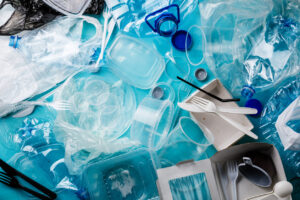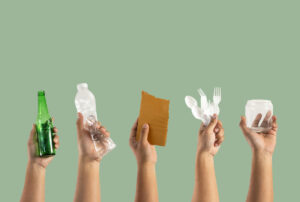[vc_row][vc_column][vc_column_text]Paper, cardboard, glass, cans and plastic – they all get thrown in together in the mixed/commingled recycling bin – so what happens after that? Have you ever wondered how recycling is sorted and processed after the KS trucks (or your council) tip your bins?
Over the next few posts we will have a look into how recycling is sorted and how the various recycling streams are processed. First of all let’s explore the sorting process…
Please note: the recycling sorting process and order can vary from facility to facility but this gives you a basic indication of what goes on.
How recycling is sorted after collection:
- Your mixed recyclables are collected by our truck drivers (truck type dependent on what size bin you have on your site).
- The recyclables are transported to a place called a Materials Recovery Facility (MRF) where the materials are loaded onto conveyors.
- First recycling is sorted manually – people at the start of the process will remove any contamination such as plastic bags, chip packets and other non-recyclable items.
- The recyclables then move along the conveyor to a large cylindrical rotating sieve called a trommel. Paper and cardboard travel through the trommel while the other items fall through the holes onto conveyor belt.
- Manual sorters then separate the paper from the cardboard, bale them up and send them off to the paper mills to begin the process of paper and cardboard recycling in Melbourne.
- Steel cans are removed on the next conveyor using a very strong overhead electro magnet and are dropped into a hopper. They are then compacted and baled ready to be sent to the steel recycler for the steel recycling process.
- Aluminium cans are pulled of the conveyor belt using an ‘eddy current’ which works like a reverse magnet. The aluminium cans are compacted and baled in a similar fashion to the steel cans and are then ready to undergo the aluminium recycling process at the aluminium smelter.
- Plastics are identified and removed either through an optical (automated) or manual sorting process. The plastics are then manually baled up depending on the type (as per the numbered code on the item) and sent to the plastics recycler to begin the plastics recycling process.
- The remaining glass is dropped off the end of the conveyor into a large container. From here it is taken to the glass recycler ready to start the glass recycling process.
It’s a good idea to become familiar with what you can and cannot put into your mixed / commingled recycling bin. If you are unsure or have any questions on mixed recycling please contact us.
Source/s: Rethink Education Centre[/vc_column_text][/vc_column][/vc_row]



